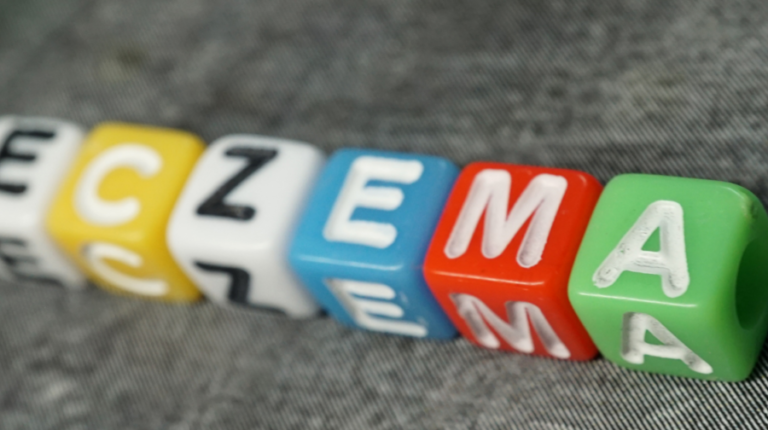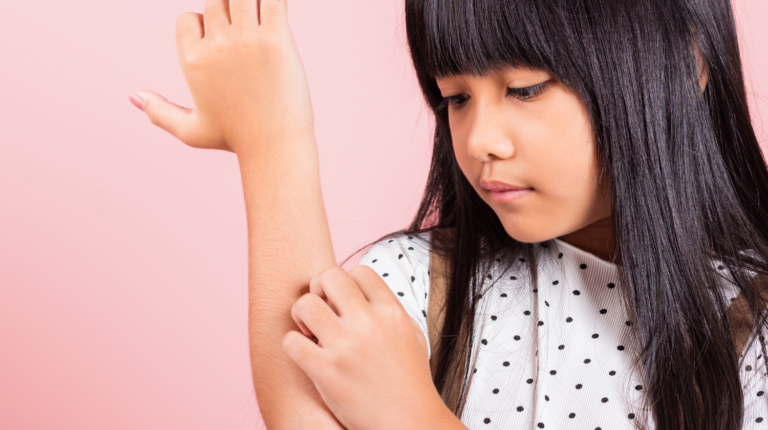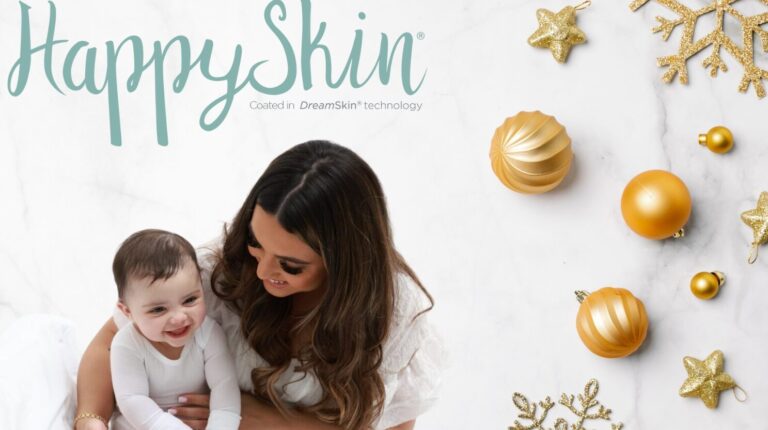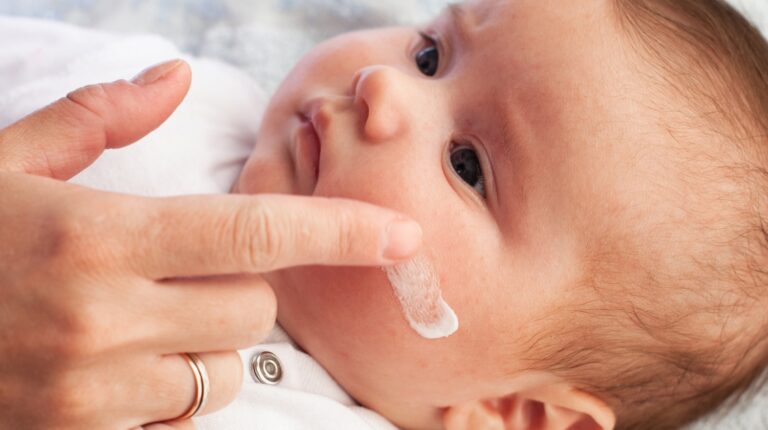
Eczema is a pretty common condition, affecting about 20% of children and just more than 10% of adults, according to the National Eczema Society.
In babies, eczema usually presents within the first 2-8 months and goes away on its own. It’s much less common in teenagers and adults.
And while there’s no cure for the condition, it is manageable and treatable when it does happen.
Managing triggers
The first step in successfully treating your baby’s eczema is to identify and remove whatever is triggering it.
Here are some common eczema triggers to avoid:
- Dry air
- High temperatures
- Long, hot baths
- Harsh soaps
- Scented products
- Chlorinated water
- Rough fabrics
- Tight clothes
- Excess sweat or saliva
- Pet hair
- Pollen
- Dust
- Smoke
- Stress
Once you notice something affecting your baby’s eczema, you can make the necessary changes to try to prevent future flare ups.
For example, if the air in your home is drying out your baby’s skin, you should use a humidifier.
Or if the skin around your baby’s mouth gets irritated from drool, clean the area gently and apply Vaseline around the mouth as a barrier before feeding or nap times.
Make sure your baby’s clothing and blankets aren’t made of heavy or scratchy fabrics, and wash them with mild detergents suitable for sensitive skin.
Keep your home clean and avoid using fragranced products on or around your baby, including things like scented baby wipes and air fresheners.
Sunlight can also have a negative effect on your baby’s eczema, so use suncream suitable for sensitive skin and cover them up as much as possible when they’re outside.
Even when you’ve eliminated most of the potential triggers, your baby could still experience dry skin and flare ups.
It’s important to maintain a daily routine to reduce the impact of eczema triggers and keep your baby’s skin as healthy and soothed as possible.
Controlling the itch
One of the biggest and most irritating symptoms of eczema is itchy skin.
Scratching an itch actually makes it more severe, and even baby nails can break skin and introduce harmful bacteria to open sores.
Keep your baby’s nails clipped short and cover their hands with mittens or cotton socks if necessary to prevent them from rubbing or scratching their eczema.
Clothing made by the eczema specialist HappySkin® include foldaway mitts and feet in their bodysuits and baby leggings.
HappySkin® clothes are also coated with a proprietary technology that reverses the effects of eczema and helps to normalise your child’s skin.
Never attempt to tie your baby’s hands or body to restrict movement, as this can cause severe distress and won’t help their eczema.
If the eczema flare-up is severe and moisturising isn’t helping as much, you could try a ‘wet wrap’ treatment which was popular in the early 2000s. This involves wetting gauze or cotton fabric strips and wrapping them over affected areas after you’ve applied moisturising cream.
Leaving these on for several hours can help soothe the skin by keeping it hydrated and preventing your baby from touching the eczema.
If the affected areas are all over the body, some parents suggest soaking your baby’s pyjamas or onesie in warm water and dressing them, adding dry pyjamas on top to stop them from getting too cold.
This process can get messy, though, and it can be stressful trying to manage a slippery baby and wet fabrics.
Specially-designed clothing to treat baby eczema is a way of simplifying this method, soothing the itch while keeping skin covered and protected from irritants.
This is where HappySkin® can help to treat your baby’s eczema.
The innovative technology used in HappySkin® clothing controls moisture levels on your baby’s skin just as normal health skin would do and helps reverse the dry, irritated and sometimes infected skin conditions caused by eczema.
HappySkin® clothing can be worn both day (bodysuits and leggings) and night (sleepsuits). Best results are achieved when HappySkin® clothing is used day and night with a very light coating of whichever creams or emollients have been prescribed by your doctor..
Moisturising skin regularly
Since eczema presents as dry and itchy skin, the best way to treat baby eczema is to keep the skin hydrated to prevent flaking and cracking.
Damaged skin can be painful for your baby and puts them at risk of infection, so repairing and maintaining the skin barrier is a vital part of eczema treatment.
The easiest way to do this is to establish a daily skincare routine for your baby, just like your baby’s bath routine.
Again, avoid using anything scented or with harsh chemicals.
These kinds of lotions can aggravate eczema and cause it to sting, making things worse for your baby.
Stick to ointments and emollient creams that have been specially formulated for babies with sensitive and dry skin.
You might have to try a few different types to find one that works best for your baby’s skin and isn’t too greasy.
Whenever you try a new product, do a patch test on a small area of skin first to see how your baby responds to it.
Apply moisturising cream several times a day, starting with the affected areas and then smoothing it into the skin all over gently.
Give the skin time to absorb it before dressing or wrapping your baby again.
Keep doing this every day even when your baby is in-between flare ups to keep the skin as hydrated as possible.
If you invest in repair and protection clothing for babies with eczema, you can skip the struggles of applying greasy creams multiple times, as the clothing will keep your baby’s skin hydrated all day.
Careful bathing routine
Some people might think that bathing a baby would soothe their eczema, but actually the opposite is true.
Yes, cleansing the skin of irritants helps, but hot water and over-washing dries out the skin and makes itchy eczema worse.
You should only bathe your baby once a day or every other day for 5-10 minutes, using lukewarm water and hypoallergenic soap and shampoo.
Never use synthetic scented soaps or bubble baths – this includes bath toys like soap crayons which contain irritating dyes.
It could be beneficial to add a natural remedy like oats, sea salt, or chamomile tea to the bathwater to see if it soothes the eczema at all.
If your baby gets fretful during bathtimes due to their eczema, distract them with fun bath toys while you wash them.
Use your hands or a soft cloth to clean your baby gently; never use anything abrasive and don’t scrub your baby’s skin.
The same goes for drying your baby after their bath – pat them dry instead of rubbing with a towel.
At this stage, you should apply any ointments and moisturisers while your baby’s skin is still damp so they can lock in the moisture.
Follow this routine consistently, even when your baby’s eczema isn’t flaring up, and you should see a marked improvement over time.
Anti-inflammatory medicines
If your baby’s eczema keeps flaring up frequently and severely despite following the steps above, you should take your baby to your family doctor.
The doctor can recommend topical steroid treatments such as a hydrocortisone cream or spray to reduce inflammation and speed up the healing process.
They might also recommend oral antihistamines, which can reduce itchiness but make your baby sleepy.
Only use these treatments as advised by the doctor.
Steroid creams should be applied after cleansing and drying your baby’s skin and before applying regular moisturiser, as regularly and for as long as directed.
If your baby’s case is particularly bad and these treatments aren’t relieving their eczema enough, further consultation with your doctor should identify your next steps.
This may include referral to a dermatologist for specialist treatments.
Looking for the fastest remedy for baby eczema?
Eczema is an ongoing condition that needs patience and constant, consistent care.
However, it’s understandably frustrating when your child is suffering from severe eczema.
There’s no quick and simple cure for eczema, but the best treatment you can give your baby is to avoid environmental triggers and keep their skin moisturised at all times, whether that’s with creams or HappySkin® technology.






